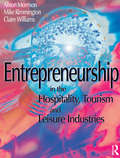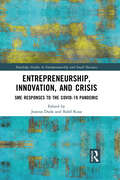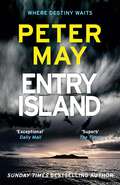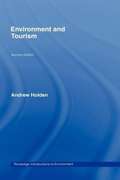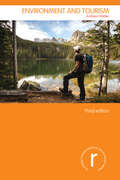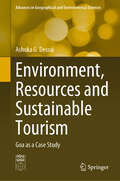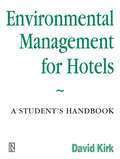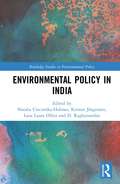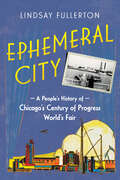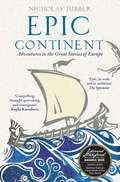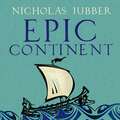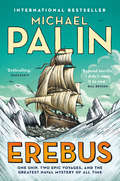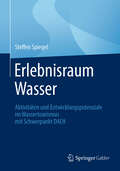- Table View
- List View
Entrepreneurship in the Hospitality, Tourism and Leisure Industries
by Michael Rimmington Clare Williams Alison MorrisonEntrepreneurship is the engine that drives any successful industry or economy. In the rapidly evolving hospitality, tourism and leisure sector worldwide this is particularly true. This new text is designed to develop a greater understanding of the process and context for entrepreneurship as well as to provide key concepts which will enable the reader to become more entrepreneurial themselves. The text unites appropriate theory with copious real world examples giving the student, manager or trainer a powerful framework for understanding every aspect of this vital business function. Rigorously developed by authors with wide teaching and industry experience it contains: *Clear learning objectives and teaching structure *Up-to-date cases throughout *The widest possible coverage of the latest research and literature *A clear focus on the dynamic hospitality, tourism and leisure sector.Entrepreneurship in the Hospitality, Tourism and Leisure Industries is an essential teaching tool and reference on all serious academic and professional courses and gives a uniquely powerful overview of the subject for students and trainees.
Entrepreneurship, Innovation, and Crisis: SME Responses to the COVID-19 Pandemic (Routledge Studies in Entrepreneurship and Small Business)
by Joanna DudaEntrepreneurship, Innovation, and Crisis: SME Responses to the COVID-19 Pandemic aims to address the conditions for the operations of SMEs during the time of the COVID-19 pandemic as well as the governmental support for entrepreneurs in such industries as tourism, manufacturing, recycling, education, and printing as well as the creative industry. Through the presentation of various strategies for the functioning and development of companies under crisis conditions along with new management approaches for coping with them, this book discusses the conditions for the operations of SMEs during the time of the COVID-19 pandemic as well as the support for entrepreneurs that has been offered by the governments of different countries. This approach will allow our results to be useful for a wide audience – making it especially valuable to researchers, academics, policymakers, and advanced students who are interested in crises, entrepreneurship, small and medium-sized enterprises, and strategic management.
Entry Island: An edge-of-your-seat thriller you won't forget
by Peter MayWINNER: DEANSTON SCOTTISH CRIME BOOK OF THE YEAR 2014WINNER: ITV SPECSAVERS CRIME THRILLER BOOK CLUB BEST READ OF THE YEAR 2014'A wonderfully complex book' PETER JAMESA detective is haunted by the feeling he knows his murder suspect - despite the fact they have never met.IF YOU FLEE FATE... When Detective Sime Mackenzie is sent from Montreal to investigate a murder on the remote Entry Island, 850 miles from the Canadian mainland, he leaves behind him a life of sleeplessness and regret. FATE WILL FIND YOU... But what had initially seemed an open-and-shut case takes on a disturbing dimension when he meets the prime suspect, the victim's wife, and is convinced that he knows her - even though they have never met. And when his insomnia becomes punctuated by dreams of a distant Scottish past in another century, this murder in the Gulf of St. Lawrence leads him down a path he could never have foreseen, forcing him to face a conflict between his professional duty and his personal destiny.LOVED ENTRY ISLAND? Read the first book in Peter May's acclaimed China thrillers series, THE FIREMAKERLOVE PETER MAY? Buy his new thriller, A SILENT DEATH(P)2013 Quercus Publishing Ltd
Entry Island: An edge-of-your-seat thriller you won't forget
by Peter MayTHE 12 MILLION COPY BESTSELLING AUTHOR OF THE LEWIS TRILOGY'Peter May is one of the most accomplished novelists writing today' Undiscovered Scotland'No one can create a more eloquently written suspense novel than Peter May' New York Journal of BooksA detective is haunted by the feeling he knows his murder suspect - despite the fact they have never met.When Detective Sime Mackenzie is sent from Montreal to investigate a murder on the remote Entry Island, 850 miles from the Canadian mainland, he leaves behind him a life of sleeplessness and regret.But what had initially seemed an open-and-shut case takes on a disturbing dimension when he meets the prime suspect, the victim's wife, and is convinced that he knows her - even though they have never met.And when his insomnia becomes punctuated by dreams of a distant Scottish past in another century, this murder in the Gulf of St. Lawrence leads him down a path he could never have foreseen, forcing him to face a conflict between his professional duty and his personal destiny.LOVED ENTRY ISLAND? Buy his new thriller, The Black Loch
Entry Island: An edge-of-your-seat thriller you won't forget
by Peter MayTHE 12 MILLION COPY BESTSELLING AUTHOR OF THE LEWIS TRILOGY'Peter May is one of the most accomplished novelists writing today' Undiscovered Scotland'No one can create a more eloquently written suspense novel than Peter May' New York Journal of BooksA detective is haunted by the feeling he knows his murder suspect - despite the fact they have never met.When Detective Sime Mackenzie is sent from Montreal to investigate a murder on the remote Entry Island, 850 miles from the Canadian mainland, he leaves behind him a life of sleeplessness and regret.But what had initially seemed an open-and-shut case takes on a disturbing dimension when he meets the prime suspect, the victim's wife, and is convinced that he knows her - even though they have never met.And when his insomnia becomes punctuated by dreams of a distant Scottish past in another century, this murder in the Gulf of St. Lawrence leads him down a path he could never have foreseen, forcing him to face a conflict between his professional duty and his personal destiny.LOVED ENTRY ISLAND? Buy his new thriller, The Black Loch
Environment and Tourism (2nd Edition)
by Andrew HoldenThis second edition of Environment and Tourism reflects changes in the relationship between tourism, society and the natural environment in the first decade of the new century. Alongside the updating of all statistics, environmental policy initiatives, examples and case studies new material has been added. This includes two new chapters: one on climate change and natural disasters and the other on the relationship between tourism and poverty. These themes have direct relevance, not only to tourism, but are reflective of the wider relationship between nature and society, a thesis that contextualizes this book. Tourism is also analyzed as an interconnected system, linking the environments of where tourists come from, with the ones they go to. Taking a holistic view of the tourism system and how it interacts with the natural environment, this volume illustrates the positive and negative effects of this relationship, and importantly how tourism can be planned and managed to encourage natural resource conservation and aid human development. It is an invaluable tool for all those studying human geography, tourism and environment studies.
Environment and Tourism (Routledge Introductions to Environment: Environment and Society Texts)
by Andrew HoldenThe global demand for tourism continues to increase as economic growth creates opportunities for its consumption as a lifestyle option across cultures. The spatial reach of recreational tourism into remoter environments reflects a desire to reconnect to nature that is partially created by the global trend toward urbanisation. At the same time, anthropogenic created environmental problems have led us to re-evaluate our relationship to nature and the values that are held by the environment. This third edition ofEnvironment and Tourism incorporates additional material on environmental philosophies and ontologies of nature and how these influence our understanding of tourism's relationship with the natural environment. In an epoch representing a critical juncture for the future well-being of the planet based on our relationship to nature, the text has been updated to reflect the growth in significance of the interaction between tourism and the natural environment as a part of this discourse. It communicates a range of key conceptual debates on the ethics and economics of the consuming nature for tourism and relates these to real world examples whilst evaluating environmental planning, and management responses. The book seeks to highlight the relevance of the significance of tourism for nature within the framework of society, as a system of inter-connected places across space and time, exploring the relationship of the environments of where tourists come from with the ones that they travel to. The updated features include: new chapters on philosophies and constructs of the environment, environmental ethics, and tourist consumption an extensive range of international case studies used to illustrate the theoretical ideas presented boxes offering bite sized insights, and think points designed to encourage students to further engage with the topics discussed Environment and Tourismemphasises a holistic view of the tourism system and how it interacts with nature, illustrating the positive and negative effects of this relationship. It emphasises how ontologies of the environment influence the planning and management of tourism for natural resource conservation and human development. It is an invaluable tool for anyone studying Human Geography, Tourism and Environmental Studies, as well as for policy makers and consultants working in the field of tourism development.
Environment, Resources and Sustainable Tourism: Goa as a Case Study (Advances in Geographical and Environmental Sciences)
by Ashoka G. DessaiThis book suggests sustainable economy from the viewpoint of tourism fostering low carbon footprint. Focussed on conserving heritage, culture and endemic biota of a crucial biodiversity hotspot of the world, the book discusses the impact of a large population, fast-paced development and excessive consumption of earth resources by tourism in a developing economy. The book (i) assesses the impact of overexploitation of earth resources on environmental components such as air, water, land and people, (ii) examines the sustainability of tourism on the physical, economic and socio-cultural environment including human lifestyles, (iii) presents the potential of tourism in promoting sustainable development, poverty alleviation and conservation of nature and (iv) formulates recommendations for tourism, fostering sustainable development in Goa, India. The book offers students, researchers, academics and professionals a comprehensive discourse integrating geological and societal perspectives on core issues. It generates critical thinking on the complex issue of sustainable tourism by providing in-depth perspective on peoples of different hues and their role in safeguarding the future of this unique region.
Environmental Impacts of Mountaineering: A Conceptual Framework (SpringerBriefs in Environmental Science)
by Michal ApolloThis book investigates the consequences of mountaineering (hiking, trekking, climbing) on the natural environment. These consequences are divided into three groups: 1) transformations caused by the mountaineer’s, or other people’s, stay in a mountaineering region; 2) transformations caused by the mountaineer’s travel (movement) through a mountaineering region, with the consideration of the ground type (rock, rock and grass, grass, residual soil, snow, ice), and 3) transformations caused by the use of mountaineering equipment. Each of the three groups are examined individually for their direct interference with the environment, i.e. caused by the main activities of climbing, trekking and hiking (both for elite and mass mountaineering) and their indirect interference caused by auxiliary activity (mainly in the case of mass mountaineering). Auxiliary activity includes guide services, transport of equipment, use of base camp facilities and the delivery of artificial support equipment, and supports the main activity. The consequences of mountaineering on the natural environment are characterized in terms of individual components of the environment (land relief, soil, vegetation, fauna, and landscape) and location/zone of mountaineering activity (hiking, trekking or climbing zone). Because of the connections and interdependence between particular components of the environment (biotic and abiotic), only preservation of each of them can bring the desired effect – a reduction in the negative impact of mountaineering. This book presents comprehensive research outcomes and serves as a platform for more detailed, future studies.
Environmental Management for Hotels
by David KirkEnvironmental Management for Hotels is a textbook for hospitality students that covers the relatively new field of environmental management. The reader is guided in how to make decisions which allow hotels to obtain optimum benefits for the environment whilst not threatening their own financial viability. Students are given an understanding of both the concepts and practical implications of environmental challenges relating to hotels. The case study material incorporated ties in theory with real life, and provides an international context. The text emphasizes supervisory issues which relate to the management of hospitality operations in ways which are sensitive to the impact on the environment. The main areas of environmental management featured are: *water *energy *the indoor environment *materials and waste.
Environmental Policy in India (Routledge Studies in Environmental Policy)
by Natalia Ciecierska-Holmes Kirsten Jörgensen Lana Laura Ollier D. RaghunandanThis book systematically introduces historical trajectories and dynamics of environmental policy and governance in India. Following the features of environmental policy in India as outlined in Chapter 1, subsequent chapters explore domestic and international factors that shape environmental policy in the country. The chapters examine the interplay between governmental and non-governmental actors, and the influence of social mobilisation and institutions on environmental policy and governance. Analysing various policy trajectories, the chapters identify and explore five central environmental policy subsystems: forests, water, climate, energy and city development. The authors drill down into the social, economic, political and ecological dimensions of each system, shedding light on why striking a balance between national economic growth and environmental sustainability is so challenging. Drawing on political science theories of policy processes and related theoretical concepts, this innovative edited volume will be of great interest to students and scholars of environmental policy and politics and South Asian studies more broadly.
Envisioning Eden: Mobilizing Imaginaries in Tourism and Beyond (New Directions in Anthropology #31)
by Noel B. SalazarAs tourism service standards become more homogeneous, travel destinations worldwide are conforming yet still trying to maintain, or even increase, their distinctiveness. Based on more than two years of fieldwork in Yogyakarta, Indonesia and Arusha, Tanzania, this book offers an in-depth investigation of the local-to-global dynamics of contemporary tourism. Each destination offers examples that illustrate how tour guide narratives and practices are informed by widely circulating imaginaries of the past as well as personal imaginings of the future.
Envisioning New Jersey: An Illustrated History of the Garden State
by Richard F. Veit Maxine N. LurieSee New Jersey history as you read about it! Envisioning New Jersey brings together 650 spectacular images that illuminate the course of the state's history, from prehistoric times to the present. Readers may think they know New Jersey's history--the state's increasing diversity, industrialization, and suburbanization--but the visual record presented here dramatically deepens and enriches that knowledge. Maxine N. Lurie and Richard F. Veit, two leading authorities on New Jersey history, present a smorgasbord of informative pictures, ranging from paintings and photographs to documents and maps. Portraits of George Washington and Molly Pitcher from the Revolution, battle flags from the War of 1812 and the Civil War, women air raid wardens patrolling the streets of Newark during World War II, the Vietnam War Memorial--all show New Jerseyans fighting for liberty. There are also pictures of Thomas Mundy Peterson, the first African American to vote after passage of the Fifteenth Amendment; Paul Robeson marching for civil rights; university students protesting in the 1960s; and Martin Luther King speaking at Monmouth University. The authors highlight the ethnic and religious variety of New Jersey inhabitants with images that range from Native American arrowheads and fishing implements, to Dutch and German buildings, early African American churches and leaders, and modern Catholic and Hindu houses of worship. Here, too, are the great New Jersey innovators from Thomas Edison to the Bell Labs scientists who worked on transistors. Compiled by the authors of New Jersey: A History of the Garden State, this volume is intended as an illustrated companion to that earlier volume. Envisioning New Jersey also stands on its own because essays synthesizing each era accompany the illustrations. A fascinating gold mine of images from the state's past, Envisioning New Jersey is the first illustrated book on the Garden State that covers its complete history, capturing the amazing transformation of New Jersey over time.View sample pages (http://issuu.com/rutgersuniversitypress/docs/lurie_veit_envisioning_sample)Thanks to the New Jersey Historical Commission, the New Jersey Council for the Humanities, and generous individual donors for making this project possible.
Eothen: Traces of Travel Brought Home from the East
by Alexander William Kinglake"My favorite travel book. Sparkling, ironic, and terrific fun." -- Jan MorrisEothen ("From the East") recaptures a bold young Englishman's exploits in the Middle East during the 1830s. Alexander William Kinglake recounts his rambles through the Balkans, Turkey, Cyprus, Syria, Palestine, and Egypt in a style radically different from other travel books of his era. Rather than dwelling on art or monuments, Kinglake's captivating narrative focuses on the natives and their cities. His adventures - populated by Bedouins, pashas, slave-traders, monks, pilgrims, and other colorfully drawn personalities - include crossing the desolate Sinai with a four-camel caravan and a sojourn in plague-ridden Cairo. A contemporary of Gladstone at Eton and of Tennyson and Thackeray at Cambridge, Kinglake offers a frankly imperialistic worldview. "As I felt so have I written," he declares in his preface, and his forthright expressions of his thoughts and impressions range in mood from confessional, to comic, to serious, to romantic. Victorian readers were captivated by Kinglake's chatty tone and his uncompromising honesty, and two centuries later this remarkable travelogue remains funny, fresh, and original.
Ephemeral City: A People's History of Chicago's Century of Progress World's Fair
by Lindsay FullertonLess celebrated than the 1893 Chicago World’s Fair, the 1933–1934 Century of Progress Exposition brought visitors face-to-face with gleaming American consumerism in the midst of the Great Depression. Lindsay Fullerton draws on a wealth of personal photographs, scrapbooks, oral histories, and writings to illuminate the wildly different experiences of fairgoers against the backdrop of a city steeped in poverty and segregation. The Exposition took place amidst massive changes sparked by expansion of mass media, Franklin Roosevelt’s election, the repeal of Prohibition, and the Great Migration. A diverse cross-section of Chicagoans informs Fullerton’s history of the event in the context of the fast-changing America of the interwar era. These personal accounts tell stories of how attendees interpreted their own experiences while being surrounded by whiz-bang products and full-throated evangelism on the benefits of progress. A colorful people’s history, Ephemeral City takes readers inside the other Chicago World’s Fair and how visitors interacted with a pivotal moment in American history.
Epic Continent: Adventures in the Great Stories of Europe
by Nicholas JubberThese are the stories that made Europe.Journeying from Turkey to Iceland, award-winning travel writer Nicholas Jubber takes us on a fascinating adventure through our continent's most enduring epic poems to learn how they were shaped by their times, and how they have since shaped us. The great European epics were all inspired by moments of seismic change: The Odyssey tells of the aftermath of the Trojan War, the primal conflict from which much of European civilisation was spawned. The Song of the Nibelungen tracks the collapse of a Germanic kingdom on the edge of the Roman Empire. Both the French Song of Roland and the Serbian Kosovo Cycle emerged from devastating conflicts between Christian and Muslim powers. Beowulf, the only surviving Old English epic, and the great Icelandic Saga of Burnt Njal, respond to times of great religious struggle - the shift from paganism to Christianity. These stories have stirred passions ever since they were composed, motivating armies and revolutionaries, and they continue to do so today.Reaching back into the ancient and medieval eras in which these defining works were produced, and investigating their continuing influence today, Epic Continent explores how matters of honour, fundamentalism, fate, nationhood, sex, class and politics have preoccupied the people of Europe across the millennia. In these tales soaked in blood and fire, Nicholas Jubber discovers how the world of gods and emperors, dragons and water-maidens, knights and princesses made our own: their deep impact on European identity, and their resonance in our turbulent times.
Epic Continent: Adventures in the Great Stories of Europe
by Nicholas Jubber'The prose is colourful and vigorous ... Jubber's journeying has indeed been epic, in scale and in ambition. In this thoughtful travelogue he has woven together colourful ancient and modern threads into a European tapestry that combines the sombre and the sparkling' Spectator'A genuine epic' WanderlustAward-winning travel writer Nicholas Jubber journeys across Europe exploring Europe's epic poems, from the Odyssey to Beowulf, the Song of Roland to theNibelungenlied, and their impact on European identity in these turbulent times.These are the stories that made Europe.Journeying from Turkey to Iceland, award-winning travel writer Nicholas Jubber takes us on a fascinating adventure through our continent's most enduring epic poems to learn how they were shaped by their times, and how they have since shaped us.The great European epics were all inspired by moments of seismic change: The Odyssey tells of the aftermath of the Trojan War, the primal conflict from which much of European civilisation was spawned. The Song of the Nibelungen tracks the collapse of a Germanic kingdom on the edge of the Roman Empire. Both the French Song of Roland and the Serbian Kosovo Cycleemerged from devastating conflicts between Christian and Muslim powers. Beowulf, the only surviving Old English epic, and the great Icelandic Saga of Burnt Njal, respond to times of great religious struggle - the shift from paganism to Christianity. These stories have stirred passions ever since they were composed, motivating armies and revolutionaries, and they continue to do so today.Reaching back into the ancient and medieval eras in which these defining works were produced, and investigating their continuing influence today, Epic Continent explores how matters of honour, fundamentalism, fate, nationhood, sex, class and politics have preoccupied the people of Europe across the millennia. In these tales soaked in blood and fire, Nicholas Jubber discovers how the world of gods and emperors, dragons and water-maidens, knights and princesses made our own: their deep impact on European identity, and their resonance in our turbulent times.
Epic Continent: Adventures in the Great Stories of Europe
by Nicholas JubberShortlisted for the Stanford Dolman Travel Book of the Year 2020Award-winning travel writer Nicholas Jubber journeys across Europe exploring Europe's epic poems, from the Odyssey to Beowulf, the Song of Roland to the Nibelungenlied, and their impact on European identity in these turbulent times. These are the stories that made Europe.Journeying from Turkey to Iceland, award-winning travel writer Nicholas Jubber takes us on a fascinating adventure through our continent's most enduring epic poems to learn how they were shaped by their times, and how they have since shaped us. The great European epics were all inspired by moments of seismic change: The Odyssey tells of the aftermath of the Trojan War, the primal conflict from which much of European civilisation was spawned. The Song of the Nibelungen tracks the collapse of a Germanic kingdom on the edge of the Roman Empire. Both the French Song of Roland and the Serbian Kosovo Cycle emerged from devastating conflicts between Christian and Muslim powers. Beowulf, the only surviving Old English epic, and the great Icelandic Saga of Burnt Njal, respond to times of great religious struggle - the shift from paganism to Christianity. These stories have stirred passions ever since they were composed, motivating armies and revolutionaries, and they continue to do so today.Reaching back into the ancient and medieval eras in which these defining works were produced, and investigating their continuing influence today, Epic Continent explores how matters of honour, fundamentalism, fate, nationhood, sex, class and politics have preoccupied the people of Europe across the millennia. In these tales soaked in blood and fire, Nicholas Jubber discovers how the world of gods and emperors, dragons and water-maidens, knights and princesses made our own: their deep impact on European identity, and their resonance in our turbulent times.(P)2019 Hodder & Stoughton Limited
Epping (Images of America)
by Corey BlanchardWith its lush forests, fertile land, and abundant waterways, Epping began attracting European settlers as early as 1710 before incorporating as an independent town in 1741. The town became home to successful farms, lumber operations, and mills built along the Lamprey River. Clay that lay beneath the fertile soil emerged as an important resource when commercial brickyards began popping up all over town in 1822. Epping became a crossroads for multiple rail lines, which spurred economic development and population booms. In 1862, undeveloped land became home to the Methodist campground Camp Hedding. Factories, especially those specializing in shoes, were established in the area as well. Epping's industrial concerns lasted until the late 20th century, when it grew as a retail center at the junction of Routes 101 and 125. Epping has been home to prominent residents, including a Revolutionary War general, three New Hampshire governors, a world heavyweight boxing champion, the first person to circumnavigate the world on a motorcycle, and a female collegiate basketball great.
Erebus: One Ship, Two Epic Voyages, and the Greatest Naval Mystery of All Time
by Michael PalinIntrepid voyager, writer and comedian Michael Palin follows the trail of two expeditions made by the Royal Navy's HMS Erebus to opposite ends of the globe, reliving the voyages and investigating the ship itself, lost on the final Franklin expedition and discovered with the help of Inuit knowledge in 2014.The story of a ship begins after the defeat of Napoleon at Waterloo, when Great Britain had more bomb ships than it had enemies. The solid, reinforced hulls of HMS Erebus, and another bomb ship, HMS Terror, made them suitable for discovering what lay at the coldest ends of the earth. In 1839, Erebus was chosen as the flagship of an expedition to penetrate south to explore Antarctica. Under the leadership of the charismatic James Clark Ross, she and HMS Terror sailed further south than anyone had been before. But Antarctica never captured the national imagination; what the British navy needed now was confirmation of its superiority by making the discovery, once and for all, of a route through the North-West Passage. Chosen to lead the mission was Sir John Franklin, at 59 someone many considered too old for such a hazardous journey. Nevertheless, he and his men confidently sailed away down the Thames in April 1845. Provisioned for three winters in the Arctic, Erebus and Terror and the 129 men of the Franklin expedition were seen heading west by two whalers in late July. No one ever saw them again. Over the years there were many attempts to discover what might have happened--and eventually the first bodies were discovered in shallow graves, confirming that it had been the dreadful fate of the explorers to die of hunger and scurvy as they abandoned the ships in the ice. For generations, the mystery of what had happened to the ships endured. Then, on September 9th, 2014, came the almost unbelievable news: HMS Erebus had been discovered thirty feet below the Arctic waters, by a Parks Canada exploration ship. Palin looks at the Erebus story through the different motives of the two expeditions, one scientific and successful, the other nationalistic and disastrous. He examines the past by means of the extensive historical record and travels in the present day to those places where there is still an echo of Erebus herself, from the dockyard where she was built, to Tasmania where the Antarctic voyage began and the Falkland Islands, then on to the Canadian Arctic, to get a sense of what the conditions must have been like for the starving, stumbling sailors as they abandoned their ships to the ice. And of course the story has a future. It lies ten metres down in the waters of Nunavut's Queen Maud Gulf, where many secrets wait to be revealed.
Erebus: One Ship, Two Epic Voyages, and the Greatest Naval Mystery of All Time
by Michael PalinIntrepid voyager, writer and comedian Michael Palin follows the trail of two expeditions made by the Royal Navy's HMS Erebus to opposite ends of the globe, reliving the voyages and investigating the ship itself, lost on the final Franklin expedition and discovered with the help of Inuit knowledge in 2014.The story of a ship begins after the defeat of Napoleon at Waterloo, when Great Britain had more bomb ships than it had enemies. The solid, reinforced hulls of HMS Erebus, and another bomb ship, HMS Terror, made them suitable for discovering what lay at the coldest ends of the earth. In 1839, Erebus was chosen as the flagship of an expedition to penetrate south to explore Antarctica. Under the leadership of the charismatic James Clark Ross, she and HMS Terror sailed further south than anyone had been before. But Antarctica never captured the national imagination; what the British navy needed now was confirmation of its superiority by making the discovery, once and for all, of a route through the North-West Passage. Chosen to lead the mission was Sir John Franklin, at 59 someone many considered too old for such a hazardous journey. Nevertheless, he and his men confidently sailed away down the Thames in April 1845. Provisioned for three winters in the Arctic, Erebus and Terror and the 129 men of the Franklin expedition were seen heading west by two whalers in late July. No one ever saw them again. Over the years there were many attempts to discover what might have happened--and eventually the first bodies were discovered in shallow graves, confirming that it had been the dreadful fate of the explorers to die of hunger and scurvy as they abandoned the ships in the ice. For generations, the mystery of what had happened to the ships endured. Then, on September 9th, 2014, came the almost unbelievable news: HMS Erebus had been discovered thirty feet below the Arctic waters, by a Parks Canada exploration ship. Palin looks at the Erebus story through the different motives of the two expeditions, one scientific and successful, the other nationalistic and disastrous. He examines the past by means of the extensive historical record and travels in the present day to those places where there is still an echo of Erebus herself, from the dockyard where she was built, to Tasmania where the Antarctic voyage began and the Falkland Islands, then on to the Canadian Arctic, to get a sense of what the conditions must have been like for the starving, stumbling sailors as they abandoned their ships to the ice. And of course the story has a future. It lies ten metres down in the waters of Nunavut's Queen Maud Gulf, where many secrets wait to be revealed.
Eredi di Tamerlano
by Peter BoehmL’irrinunciabile guida per un viaggio in Asia centrale. EREDI DI TAMERLANO contiene reportage da Kazakistan, Turkmenistan, Uzbekistan, Kirghizistan e Tagikistan e spaccati di realtà a noi lontane: il cibo centroasiatico, la nuova capitale kazaka Astana, il massacro di Andijan, la scomparsa del lago d’Aral, il capo dei capi: il grande Türkmenbaşy, il buzkashi, Samarcanda, il rapimento delle spose, donne che si suicidano col fuoco, il traffico uzbeko, e tanto altro.
Erie Canal Traveler's Guide: Restaurants, Pubs, and Attractions within a Stone's Throw of the Canal Path
by Larry WeillCelebrate 200 Years of the Erie Canal with this guide offering 200+ dining and attraction highlights along the historic path.Completed in 1825, the Erie Canal spans 363 miles across New York State to connect Albany and Buffalo, which made it an indispensable tract for commerce 200 years ago. While the canal&’s use as a primary means of moving commercial goods across the state has been replaced by trucks and trains, its recreational usage has increased exponentially since then. The Canal Path that parallels the waterway has become a mecca for hikers, bikers, and runners of all ages. In celebration of the Canals&’ 200th anniversary, The Erie Canal Traveler&’s Guide features more than 200 restaurants, pubs, and attractions for the entire family and the curious traveler alike, all within &‘a stone&’s throw&’ – or, to be precise, 445 feet and ten inches – of the Canal Path. Across 14 counties and many more towns and cities, establishments located along the Canal flourish. This helpful and handy account is bursting with over 200 listings with location and menu details, descriptions, and photos: explore Lockport&’s Upside-Down Train Trestle in Niagara County; have breakfast at local gems such as The Village Coal Tower Restaurant in Monroe County; visit Kirby&’s Cider Mill in Orleans Country; hike through the Mohawk Valley Welcome Center in Montgomery Country and afterwards, quench your thirst with an ice-cold glass of milk at The Dairy Bar. Visitors to Upstate New York will discover a plethora of new favorite places alongside the Canal, and locals that know how special the Erie Canal Path is will find even more to love with The Erie Canal Traveler&’s Guide.
Erie County Fair (Images of Modern America)
by Martin Biniasz Erie County Agricultural SocietyFrom its humble, pioneer beginnings to its current incarnation as the largest independent county fair in the United States, the Erie County Fair in Hamburg, New York, is a beloved western New York institution. Annually, over one million people flock to its historic fairgrounds located just south of Buffalo to celebrate agriculture, showcase time-honored traditions, keep the spirit of competition alive, and, most importantly, come together as a community. Through vintage photographs, Erie County Fair presents a visual narrative of the fair's history and stimulates cherished memories rooted in decades of excitement found at this annual summer gathering. The continuity of the American county fair spirit is most evident through these images from the archives of the Erie County Agricultural Society.
Erlebnisraum Wasser: Aktivitäten und Entwicklungspotenziale im Wassertourismus mit Schwerpunkt DACH
by Steffen SpiegelDieses Buch gibt einen umfassenden Überblick über die wesentlichen Aspekte des Wassertourismus an Küsten, Flüssen, Kanälen und Seen. Neben der konzeptionellen Einordnung in das touristische Gesamtsystem beleuchtet es Angebot und Nachfrage wassertouristischer Dienstleistungen in Deutschland und den Nachbarländern. Besonderes Augenmerk wird auf Bezüge zur Nachhaltigkeit gelegt. Mit vielen Praxisbeispielen bietet das Werk eine Fülle an Anregungen für touristische Dienstleister, Praktiker aus dem Destinationsmanagement und Politiker. Es wendet sich ebenso an Forschende, Lehrende und Studierende der Fachgebiete Tourismus, Geographie und Wasserwirtschaft.Der Inhalt• Wassertourismus und das touristische Gesamtsystem• Infrastruktur für den Wassertourismus• Nachfrage wassertouristischer Dienstleistungen• Angebot wassertouristischer Dienstleistungen• Destinationsmarketing für Wassertourismus• Wassertouristische Destinationen• Nachhaltigkeit• Ausblick: Wie wird sich der Wassertourismus weiterentwickeln?
